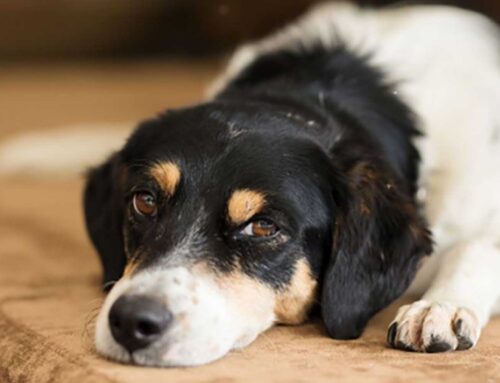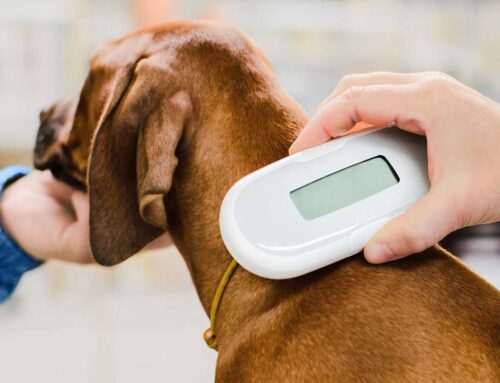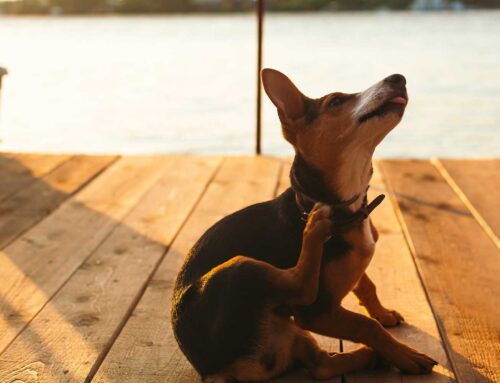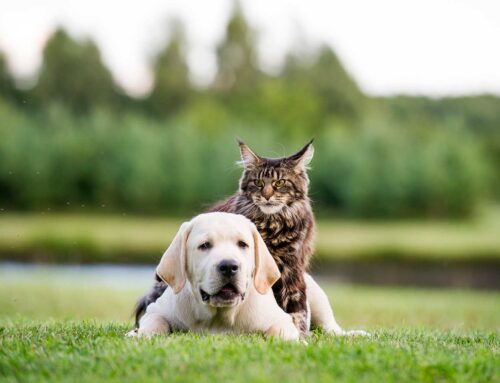Whelping usually occurs with relatively few problems. Dogs can usually deliver their puppies with little help from owners. This information is provided to help determine if an abnormality is present.
Most dogs whelp approximately 63 days after breeding (normal range of 58 to 71 days). It can be helpful to start taking your dog’s rectal temperature with a glass-bulb thermometer from about 55 days after breeding. Make sure it is inside the anus and ideally against the wall of the rectum. Take the reading after about 30 seconds. When the temperature falls approximately 1oC (to between approximately 37.0oC & 37.5oC), the dog should whelp within 24 hours. You should have a place set aside for her that is warm and private. She may pick a place for herself and start nesting behaviour there as she nears whelping. It is useful to have clean towels, iodine, thread or dental floss, a small set of scales, vanilla ice cream, & the vet’s phone number.
Labour starts with a long stage in which the uterine contractions begin, the birth canal relaxes, and the cervix opens. The abdominal contractions may not be visible. Your dog may be restless or nervous, pant or vomit. This stage lasts 6 to 12 hours.
The second stage is the actual birth of the puppies. You will usually see foetal tissues protruding from the vulva before you actually see a pup born. Remember breech deliveries (back feet first) are normal. The puppies are born covered by a membrane that the dog ruptures with her teeth. She also bites through the umbilical cord of each pup. Abdominal contractions are evident at this stage. Observe the dog without disrupting her. When you see the hard abdominal contractions signaling the start of second stage of labour, you should give your dog two hours to have the first pup. Once you see foetal tissues protruding, a pup should be born within 30 minutes. Allow up to two hours between pups – most dogs have a pup every 30 to 60 minutes. Some dogs may have several pups and then rest a while before finishing. If you are unsure about whether the whelping is progressing normally, call your veterinarian. Twenty to thirty minutes of constant hard pushing is often indicative of a pup being stuck in the canal. Another sign of a problem is the appearance of a dark green discharge.
The third and final stage of labour is that of expelling the placenta or afterbirth. The dog usually expels the placenta for each pup after it is born and sometimes expels two placentas after delivering two pups. You should clean these away; there is no good physiologic reason for allowing the bitch to eat them . Trying to count the placentas is notoriously unreliable, but you can try.
Your assistance may be necessary. If a puppy is stuck, use lots of water-soluble lubrication eg, KY Jelly, & gently pull the head or body downwards over the pelvic brim. If the mother does not clean the pups, you should towel dry them, rubbing vigorous with the head pointing downwards, remembering to clean the mouth & nose of secretions. If the mother does not severe the umbilical cord, tie it in two places (the closest one should be an inch from the pup). Cut between the two ties and dip the end of the cord in iodine. Leave the pups with the bitch; even though she may not let them nurse, they need her warmth and physical contact. Many bitches will eat a special treat such as vanilla ice cream while whelping. Vanilla ice cream is good for bitches during whelping as it provides energy and calcium.
After whelping is completed, make sure all the pups nurse within 12 to 18 hours. The first milk (colostrum) they receive is important in providing them with immunity to many common diseases. Warmth is very important but be careful with heating pads or heat lamps. The mother may have a green to red-brown discharge for up to 3 weeks after whelping. This is normal and is no concern as long as it is not foul smelling and she seems fine otherwise. Inspect the mother’s mammary glands daily for the presence of milk, any abnormal swellings and pain. The puppies should be weighed at birth and daily thereafter. They may lose a small amount of weight on the first day but should gain steadily after that, doubling their birth weight by 10-14 days of age.
The following is a checklist of reasons to call us on 9626 9561:
- the dog started labour and is not progressing within the time limits just listed
- the rectal temperature dropped more than 24 hours ago and the dog has not started labour
- the dog appears ill, depressed, feverish or fatigued
- you have trouble getting the puppies to breathe early on or to suckle later
- you are not sure if the dog has finished whelping
- you have particular questions or concerns.
Remember, to start
- worming the puppies every two weeks from two weeks of age
- offering the pups tin puppy food or moistened dry puppy food from 3 weeks of age so they are ready for weaning at 6 weeks of age
- vaccinations and microchipping is recommended at 6 weeks of age.
Information provided by Margaret V. Root Kustritz & Autumn P. Davidson






